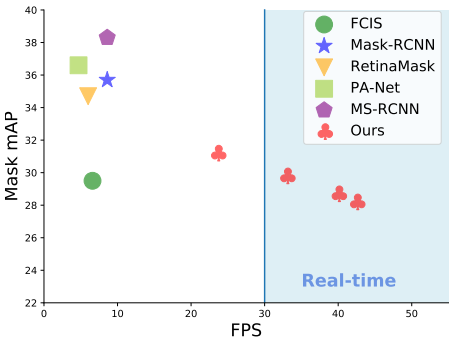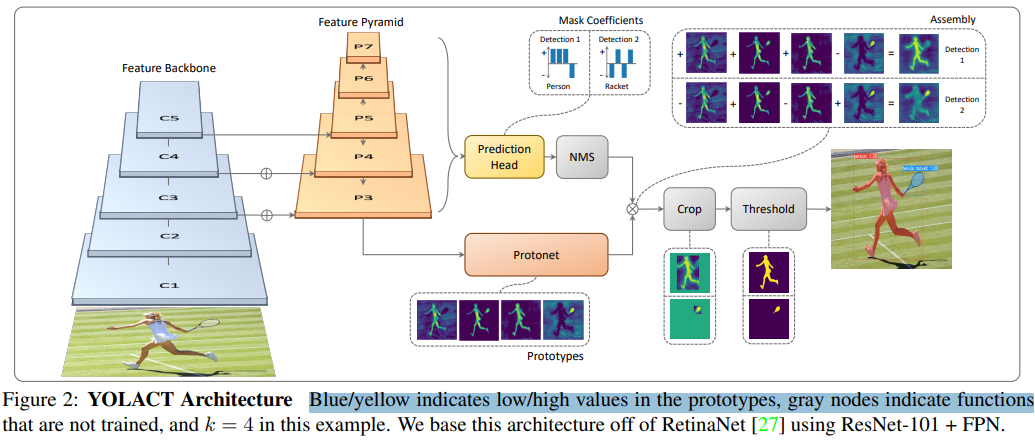InstanceSegment

- present a simple, fully-convolutional model for real-time instance segmentation that faster than any previous competitive approach.
generating a set of prototype masksandpredicting per-instance mask coefficients. And produce instance masks by linearly combining the prototypes with the mask coefficients.


- prototype generation: predicts a set of k prototype masks for the entire image.
- taking protonet from deeper backbone features produces more robust masks, and higher resolution prototypes result in both higher quality masks and better performance on smaller objects.
- predicts k mask coefficients, one corresponding to each prototype.



Relative
- focus primarily on performance over speed, leaving the scene devoid of instance segmentation parrallels to real-time object detectors like SSD, and YOLO.
- Instance Segmentation:
- Mask-RCNN: two-stage instance segmentation approach that generates candidate region-of-interests and then classifies and segments the ROIs.
- semantic segmentation followed by boundary detection, pixel clustering or learn an embedding to form instance masks.
- Real-time Instance Segmentation:
- Mask R-CNN remains one of the fastest instance segmentation methods on semantically challenging datasets like COCO;
Code
- backbone结构


- FPN 结构

- proto结构
Protonet 的设计是受到了 Mask R-CNN 的启发,它由若干卷积层组成。其输入是0,其输出的 mask 维度是 13813832,即 32 个 prototype mask,每个大小是 138*138。

- predict_head


’loc’:每个anchorbox的预测偏移量,形状为(1,19248,4)
‘conf’:每个anchorbox的类别预测,形状为(1,19248,num_class)
‘mask’:就是论文中指出的mask系数,形状为(1,19248,32)
‘priors’:预设的anchorbox的坐标,形状为(19248,4)
‘proto’:与mask系数配合使用的分割特征图,形状为(1,138,138,32)
‘segm’:得到一个类似分割的热度图,这里的形状为(1,num_class-1,69,69),我估计segm是为了使得网络快速收敛用的。
- 损失函数
net:就是上面的网络结构。
preds:是一个字典,上面红色字体部分就是preds中字典的内容。
targets:一般的形状为(batch,n,5),batch就是输入了常规的batchsize,n表示一张图片中有几个目标物体,5当中前4个表示目标物体的坐标,第5个数字表示该目标物体的类别。
masks:一般形状为(batch,n,550,550),这个n不是固定的,batch中的每张图片得到的目标物体数量都不相同,这个mask和maskrcnn那个是一样的。
num_crowds:(batch,)表示拥挤程度,0表示不拥挤,1表示拥挤,一般都是0。
2. Railroad is not a Train
Lee, Seungho, et al. “Railroad is not a Train: Saliency as Pseudo-pixel Supervision for Weakly Supervised Semantic Segmentation.” arXiv preprint arXiv:2105.08965 (2021).
本次工作所提出方案:提出 Explicit Pseudo-pixel Supervision(EPS),通过结合两个弱监督从像素级反馈中学习;图像级标签通过 localization map,以及来自现成的显著检测模型提供丰富边界的 saliency map 来提供目标身份。作者进而又设计一种联合训练策略,可以充分利用两种信息之间的互补关系。所提出方法可以获得准确的物体边界,并摒弃共同出现的像素,从而显著提高 pseudo-masks 的质量。
- 论文链接:https://arxiv.org/abs/2105.08965
- 项目链接:https://github.com/halbielee/EPS
